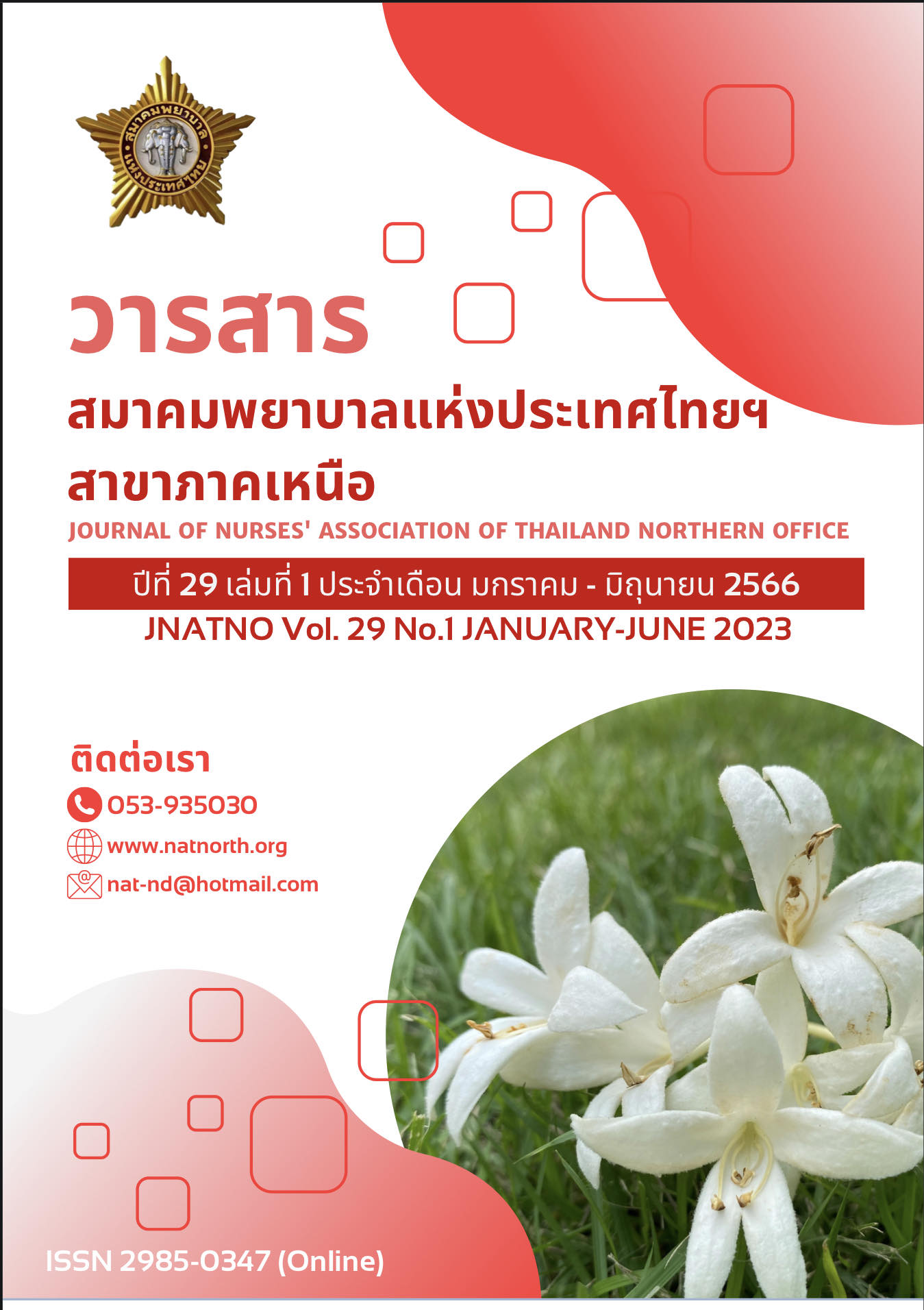The ผลของการพยาบาลทางไกลต่อความสามารถของผู้ดูแล ในการดูแลผู้ป่วยโรคหลอดเลือดสมอง หลังจำหน่ายกลับบ้าน โรงพยาบาลประสาทเชียงใหม่
คำสำคัญ:
ผู้ป่วยโรคหลอดเลือดสมอง, ผู้ดูแลผู้ป่วย , ความสามารถในการดูแลผู้ป่วยบทคัดย่อ
การวิจัยกึ่งทดลอง ศึกษาในกลุ่มตัวอย่างกลุ่มเดียวโดยวัดผลก่อนและหลังการศึกษา วัตถุประสงค์เพื่อประเมินผลของการพยาบาลทางไกลต่อความสามารถของผู้ดูแลในการดูแลผู้ป่วยโรคหลอดเลือดสมองที่จำหน่ายกลับบ้าน โรงพยาบาลประสาทเชียงใหม่ กลุ่มตัวอย่างเป็นผู้ดูแลผู้ป่วยโรคหลอดเลือดสมอง จำนวน 33 คน เครื่องมือที่ใช้ในการศึกษาประกอบด้วย 2 ส่วน 1) เครื่องมือที่ใช้ในการทดลองคือ แนวทางการพยาบาลทางไกล 2) เครื่องมือที่ใช้ในการรวบรวมข้อมูล ได้แก่ แบบสอบถามข้อมูลทั่วไปของผู้ดูแลผู้ป่วย แบบสอบถามข้อมูลทั่วไปของผู้ป่วยโรคหลอดเลือดสมอง แบบประเมินความสามารถในการปฏิบัติกิจวัตรประจำวันของผู้ป่วย แบบประเมินความสามารถในการดูแลผู้ป่วยโรคหลอดเลือดสมอง และแบบประเมินความพึงพอใจของผู้ดูแลผู้ป่วยต่อการพยาบาลทางไกล ผ่านการตรวจความตรงทางเนื้อหา โดยผู้ทรงคุณวุฒิ จำนวน 3 ท่าน และตรวจสอบความเที่ยงของเครื่องมือ โดยหาค่าสัมประสิทธิ์แอลฟาของครอนบาค (Cronbach’s alpha coefficient) ซึ่งแบบประเมินความสามารถในการปฏิบัติกิจวัตรประจำวันของผู้ป่วย และแบบประเมินความสามารถในการดูแลผู้ป่วยโรคหลอดเลือดสมอง แบบประเมินความพึงพอใจของผู้ดูแลผู้ป่วยต่อการพยาบาลทางไกลได้ค่าความเที่ยงเท่ากับ .88, .87 และ .90 ตามลำดับ วิเคราะห์ข้อมูลโดยใช้สถิติเชิงพรรณนาและสถิติอ้างอิง Wilcoxon signed ranks test
ผลการวิจัย พบว่า หลังจากได้รับการดูแลผ่านการพยาบาลระดับความสามารถของผู้ดูแลเพิ่มขึ้นอย่างมีนัยสำคัญทางสถิติ (p < 0.05) ระดับความพึงพอใจของผู้ดูแลผู้ป่วยต่อการติดตามดูแลผู้ป่วยทางไกล อยู่ในระดับมากร้อยละ 86.7 การติดตามประเมินความสามารถในการปฏิบัติกิจวัตรประจำวันของผู้ป่วยวันที่จำหน่ายออกจากโรงพยาบาลและหลังให้การพยาบาลทางไกลจนครบ 6 เดือน พบว่าไม่มีความแตกต่างกันอย่างมีนัยสำคัญ (p = .317)
จึงสรุปได้ว่า การพยาบาลทางไกล สามารถเพิ่มระดับความสามารถในการปฏิบัติการดูแลผู้ป่วยโรคหลอดเลือดสมองของผู้ดูแลได้ นอกจากนี้การพยาบาลทางไกลช่วยเพิ่มความพึงพอใจให้แก่ผู้ดูแลได้ ข้อเสนอแนะจากการวิจัยนี้ได้แก่ การพยาบาลทางไกลเป็นอีกวิธีหนึ่งในการให้การดูแลผู้ป่วยในยามที่มีโรคระบาด และใช้ในการดูแลผู้ป่วยที่อยู่ในพื้นที่ห่างไกล
เอกสารอ้างอิง
สมศักดิ์ เทียมเก่า. สถานการณ์โรคหลอดเลือดสมอง. วารสารประสาทวิทยาประเทศไทย 2021;37(4):54-60.
กระทรวงสาธารณสุข กองควบคุมโรค. รณรงค์ให้ประชาชน “รู้สัญญาณเตือน โรคหลอดเลือดสมอง เสี้ยวนาที มีค่าช่วยชีวิต” [อินเทอร์เน็ต]. 2564 [เข้าถึงเมื่อ 7 พฤศจิกายน 2564]. เข้าถึงได้จากhttps://ddc.moph.go.th/brc/news.php?news=21374 & deptcode.
Bakas T, Farran CJ, Austin JK, Given BA, Johnson EA, Williams LS. Stroke caregiver outcomes from the Telephone Assessment and Skill-Building Kit (TASK). Top Stroke Rehabil. 2009;16(2):105-21. doi: 10.1310/tsr1602-105. PMID: 19581197.
สุพิมล บุตรรัตนะ. ผลของโปรแกรมเตรียมความพร้อมของผู้ดูแลหลักผู้ป่วยโรคหลอดเลือดสมองตีบ ตัน ก่อนจำหน่ายกลับบ้าน โรงพยาบาลหนองบัวลำภู. วารสารการพยาบาลสุขภาพและการศึกษา 2563;3(1):56-64.
Kord Z, Fereidouni Z, Mirzaee MS, Alizadeh Z, Behnammoghadam M, Rezaei M, Abdi N, Delfani F, Zaj P. Telenursing home care and COVID-19: a qualitative study. BMJ Support Palliat Care 2021:bmjspcare-2021-003001. doi: 10.1136/bmjspcare-2021-003001. PMID: 34187878.
Afik A, Glorino Rumambo Pandin, M. Telenursing as a new nursing paradigm in the 21 Century: A literature review. Preprints [Internet]. 2021 [cited 7 Nov 2021]. Available from: https: //doi.org/10.20944/ preprints 202103. 0704.v1
Nejadshafiee M, Bahaadinbeigy K, Kazemi M, Nekoei-Moghadam M. Telenursing in incidents and disasters:A systematic review of the literature. J Emerg Nurs. 2020 Sep;46(5):611-622. doi: 10.1016/j.jen.2020.03.005. Epub 2020 Apr 29. PMID:32360295.
สุพัตรา ปวนไฝ, ศรีวรรณา วงค์เจริญ, นิรมัย มณีรัตน์, และวราพร นนทศิลา. ประสิทธิผลการใช้โปรแกรมการดูแลตามระยะเปลี่ยนผ่าน ผู้ป่วยสูงอายุโรคหลอดเลือดสมองในโรงพยาบาลประสาทเชียงใหม่ ต่อความสามารถในการปฏิบัติกิจวัตรประจำวันและคุณภาพชีวิต. วารสารวิชาการสาธารณสุข 2561;27(3): 500–9.
Jönsson AM, Willman A. Implementation of telenursing within home healthcare. Telemed J E Health 2008 Dec;14(10):1057-62. doi: 10.1089/tmj.2008.0022. PMID: 19119827.
ธีรภัทร อดุลยธรรม. Cloud meeting – Telemedicine กับบุคลากรทางการแพทย์ ในยุคโควิด - 19. วารสารกรมการแพทย์ 2563;45(2):5–7.
ชัยยุทธ โคตะรักษ์. ปัจจัยที่มีความสัมพันธ์กับพฤติกรรมสุขภาพของผู้สูงอายุโรคหลอดเลือดสมองกลับเป็นซ้ำ. [วิทยานิพนธ์พยาบาลศาสตรมหาบัณฑิต]. ชลบุรี: มหาวิทยาลัยบูรพา; 2563.
Moradi, V., Babaee, T., Esfandiari, E., Lim, S. B., & Kordi, R. Telework and telerehabilitation programs for workers with a stroke during the COVID-19 pandemic: A commentary. Work (Reading, Mass.) 2021;68(1):77–80.
ดาวน์โหลด
เผยแพร่แล้ว
รูปแบบการอ้างอิง
ฉบับ
ประเภทบทความ
สัญญาอนุญาต
ลิขสิทธิ์ (c) 2023 สมาคมพยาบาลแห่งประเทศไทยฯ สาขาภาคเหนือ

อนุญาตภายใต้เงื่อนไข Creative Commons Attribution-NonCommercial-NoDerivatives 4.0 International License.
บทความที่ได้รับการตีพิมพ์เป็นลิขสิทธิ์ของสมาคมพยาบาลแห่งประเทศไทยฯ สาขาภาคเหนือ
เนื้อหาและข้อคิดเห็นใดๆ ที่ตีพิมพ์ในวารสารสมาคมพยาบาลฯ ถือเป็นความรับผิดชอบของผู้เขียนเท่านั้น ผู้เขียนบทความต้องศึกษารายละเอียดหลักเกณฑ์การจัดทำต้นฉบับตามที่วารสารกำหนด และเนื้อหาส่วนภาษาอังกฤษต้องได้รับการตรวจสอบจากเจ้าของภาษามาแล้ว


